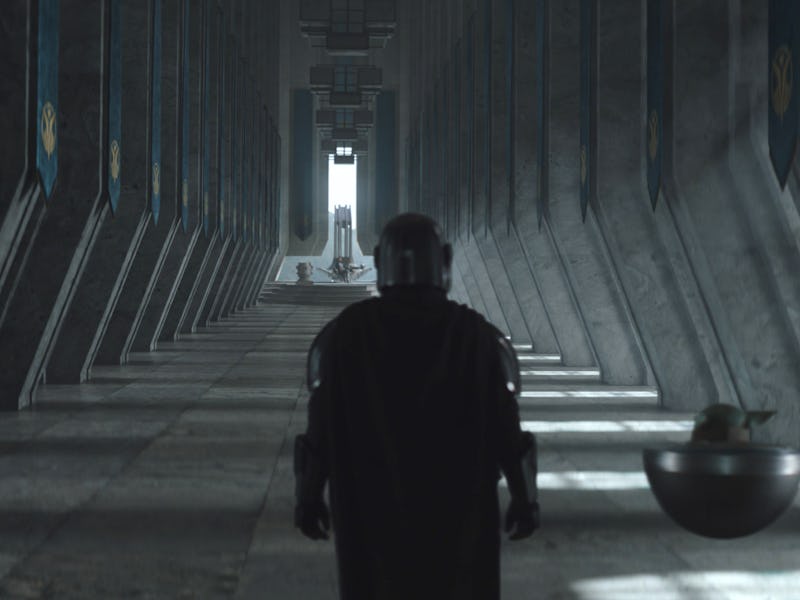Mandalorian Season 3 Could Finally Fix The Biggest Gap in Star Wars Canon
The tonal differences between the Mandalorians of the cartoons and those of live-action are massive.

Way back before George Lucas sold Lucasfilm to Disney in 2012, the canonical boundaries of Star Wars were in flux. When The Clone Wars started airing on the Cartoon Network in 2008, “the expanded universe” of Star Wars comics and novels was still alive and kicking. But, post-2014, those comics and novels were ejected from the canon, while The Clone Wars, very retroactively, became part of the “real” canon. Because The Clone Wars is the bulkiest retcon in all of Star Wars, its aesthetics and tone feel discordant from the rest of the saga, especially The Mandalorian. But now, The Mandalorian Season 3 is quietly trying to fix all that.
Mandalore revealed
Mando and Grogu in The Mandalorian Season 3.
After two seasons of teasing, Mandalorian Season 3 seems poised to explore what hardcore fans have long been curious about: what does Mandalore actually look like in the post-Return of the Jedi era? But, contained within that question is also the fact that for most viewers, the backstory of Mandalore essentially doesn’t exist. Bo-Katan and the Nite Owls may be well-known to the most serious Star Wars devotee, but for many Mando fans, Katee Sackhoff’s appearance in Season 2 was their introduction to that character.
Like Ahsoka Tano, Cad Bane, and other characters imported from the animated shows into live-action, the number of fans familiar with those characters pre-Mando is a tiny minority compared to the mainstream majority who flocked to The Mandalorian in 2019. Among the many reasons for this, The Clone Wars was hard to reliably watch prior to Disney+, while Rebels initially aired on the relatively obscure Disney XD. But, in 2019, the launch of Mando and Disney+ created a centralized monoculture for all of Star Wars television past, present, and future.
So, in theory, folks that slept on the animated shows can go back and educate themselves on the “real” Mandalore of the Anakin and Obi-Wan era of The Clone Wars. And guess what that would cause? Utter confusion.
A tale of multiple Mandalorians
Various Mandalorians in Season 3, although these are all the same “kind” of Mandalorians.
In The Clone Wars Season 2, with the episode “The Mandalore Plot,” Star Wars canon defined the status quo of the Mandalorians as something utterly unrecognizable to someone who’s only seen The Mandalorian. Back then, Dave Filoni pointed out that this version of Mandalorian society was “how George has always envisioned the Mandalorians.” Determining the relative truth of this statement is tricky: George Lucas is a brilliant revisionist who convinced everyone he always planned on making Darth Vader Luke’s father and that Leia was always Luke’s sister, even though that level of planning is demonstrably untrue.
In The Clone Wars, the nature of Lucas’ Mandalorian culture is fractured: some are peace-seeking people who want to give up their warrior past, and others are people who wear Mandalorian armor and jet around like the Star Wars version of Iron Man. Whether Lucas intended this conflict from the beginning doesn’t matter, because this division came to define Mandalorians: boring pacifists versus Boba Fett-esque warriors. And, oddly enough, this split got even bigger when The Mandalorian hit.
This is a Way
Although it wasn’t made clear until Season 2, the Mandalorian creed presented in The Mandalorian belongs only to an extreme sect of Mandalorians, one so fringe that no one even knew about them in The Clone Wars. The cult-like idea of not taking off your helmet wasn’t part of Lucas’ version of Mandalorians, but the idea of more Boba Fett-esque Mandos didn’t contradict the conflict set up in “The Mandalore Plot,” either. The Way, which Din Djarin speaks of so often, is simply a way for Mandalorians to behave. The existence of a live-action Bo-Katan in Season 2 only made this odd split a bigger deal. In fact, bringing Bo-Katan to The Mandalorian turned a canon inconsistency into a plot point.
Carl Weathers may not realize it, but Din Djarin is a weird outlier.
Now that plot point is central to Season 3. Because of the popularity of The Mandalorian itself, the extremist fringe Mandalorians are the biggest in popular consciousness. This makes the stakes of The Mandalorian Season 3 oddly meta: Din Djarin desperately wants to be accepted by his old sect, the Children of the Watch, and go back to his old ways of never showing his face or removing his helmet in front of anyone.
Why this is so important to Din is a discussion for another day, but what it represents for Star Wars is a little more seismic than it might seem. Mando can’t truly be a Mandalorian until he does what the Armorer tells him to do and finds those living waters. But, the Star Wars completist — represented in the show by Bo-Katan — knows that Din is a Mando-poser, and that what it means to be a “real” Mandalorian is a little more complex than performing rituals.
The first two seasons of The Mandalorian were mostly about Baby Yoda, but Mando Season 3 seems to be fixated on Mandalorian culture itself. And if most fans are still fuzzy about why Bo-Katan is one kind of Mandalorian and Din is a different kind, this season seems determined to fix that. Star Wars is about to re-educate everyone about Mandalorian history, and that means we should expect a lot of retconning along the way.